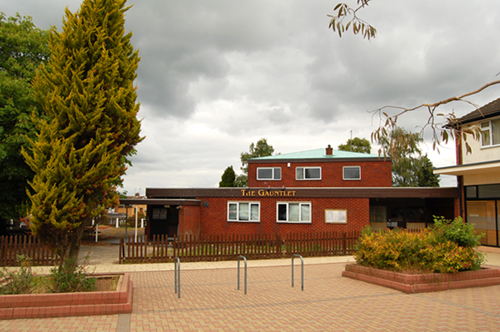Early Days of The Gauntlet
(First published in the Kenilworth Weekly News, 24th June 2011)

As The Gauntlet heads towards its new lease of life, it is interesting to look back at the early days of one of Kenilworth’s newest pubs.
Post-war, Kenilworth had something of a housing boom to the west of Warwick Road, and as the Bulkington and Oaks estates grew in the 1950s, thoughts obviously turned to providing facilities for initially hundreds, and eventually thousands, of new residents.
In 1958, there were plans to build a new pub in Beauchamp Road, centrally in the newly developed area, but the brewery involved let the agreement slip and bungalows were built on the site instead.
In 1959, plans were put in hand to extend the then recently made short cul-de-sac Scott Road across the field then occupied by Kenilworth Rangers Football Club. Its changing room, tuck shop and meeting room were demolished to make way for Caesar Road; it was the pitch site that was chosen to provide the only new facilities in the whole of the ‘western Kenilworth’ development – a garage, a small shopping precinct and a pub.
A new pub in Kenilworth was something of a novelty; the previous one was The Wyandotte, opened in 1869. The brewery involved in the new venture was Phipps of Northampton; although well established in Leamington, Coventry and other places, The Gauntlet was its first venture in Kenilworth. The design was by the brewer’s own architects and surveyors who also supervised the construction, started in late 1963, by Thomas Bates and Co.
Incidentally, Thomas Bates himself re-housed Kenilworth Rangers in his back garden – he lived at Thickthorn so his back garden was rather large!
‘The Gauntlet’ opened on Wednesday 22nd April 1964. It had two bars, a covered terrace and a large paved area, still all features of the pub. The theme of the décor was the country pursuits and sports of the middle ages when the castle was in its prime. Beers were cooled in the cellar and gas fired central heating gave warmth in the bars. Background music was provided either by radio or by a record player. The upper floor had accommodation for the manager – a kitchen, living room, bathroom and three bedrooms being provided.
A 20ft chestnut tree was planted and today it dominates the entire terrace area.
‘The Gauntlet’ is a unique name for an English pub; surprisingly for a town of its size Kenilworth appears to have four other uniquely named pubs. The others thought so to be are The Wyandotte, The Tiltyard, Queen & Castle and Virgins and Castle.
In 1960, Phipps Brewery was taken over by London brewers Watney but within eight years Watney had disposed of all traditional draught bitters and replaced them with keg. Watney’s treatment of Phipps ales drinkers was a key event in the origins of the Campaign for Real Ale in 1971.
As was then quite common at pubs, The Gauntlet had an off licence or ‘outdoor’. One particularly popular drink at the time, and prominently displayed in the window of the outdoor, were tins of four or seven pints of beer, called not surprisingly “Party Four” and “Party Seven”. In the 1970s, many a teenage party on the Oaks estate was fuelled by cans of “Party 7” bought at The Gauntlet.
Having waited 95 years for a new pub, another for Kenilworth came along the following year with the opening of The Woodcock in Whitemoor Road; it was demolished just 41 years later. The well-situated and popular Tiltyard opened in 1987 to serve the new estates of ‘eastern Kenilworth’; it remains to be seen if The Gauntlet can again successfully provide the needs of those living in ‘the west’.